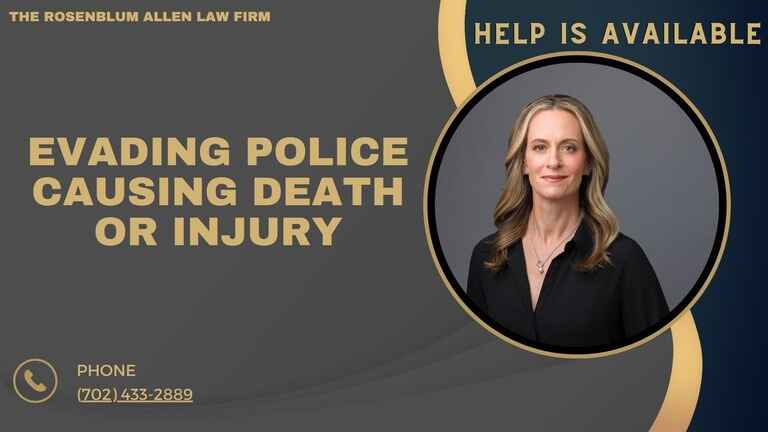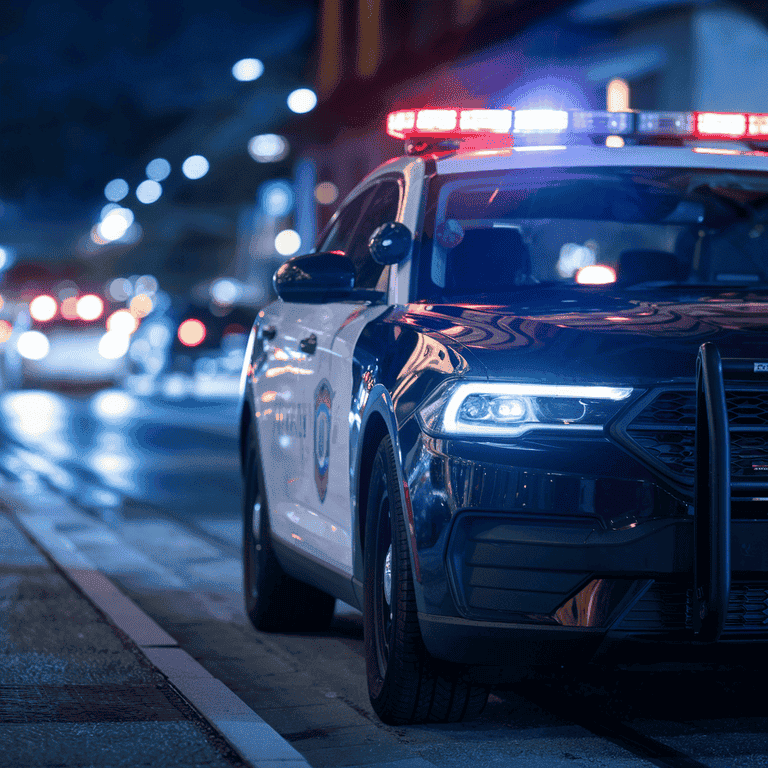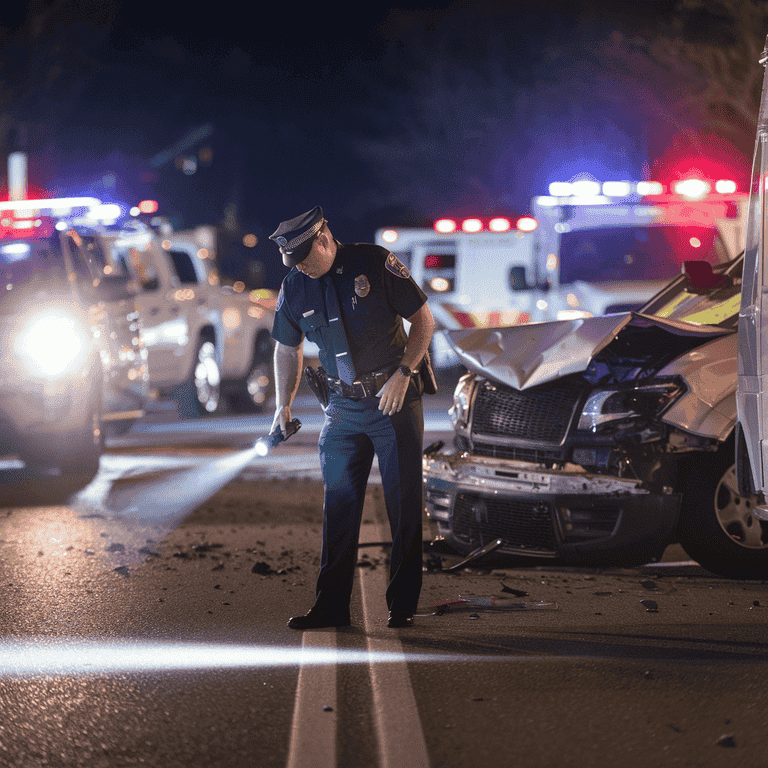Overview of Evading Police Causing Death or Injury
Definition of Evading Police
Evading police happens when a driver intentionally ignores or flees from law enforcement efforts to stop them. This is more than just avoiding a traffic ticket. It involves willfully disregarding a police officer’s instructions to pull over or stop.
Everyday actions that can be considered evading police include:
- Speeding away after police signal to stop
- Running through a roadblock or checkpoint
- Taking evasive actions during a police chase, such as high-speed driving or dangerous maneuvers
In situations where evading leads to injury or death, the legal consequences are dire. Evading itself is a crime, but if someone gets hurt or killed during the attempt, the penalties increase significantly.

Understanding Charges When Evading Police Results in Death or Injury
When someone’s attempt to evade law enforcement leads to injury or death, the charges are escalated. The law considers the risks to the officers, bystanders, or anyone else caught up in the incident. This means that if evading police results in someone’s injury or death—whether directly or indirectly—the driver faces more severe consequences.
This escalation usually depends on the following:
- Injury or Death: Injuries typically lead to different charges than those involving fatalities.
- Circumstances of the Chase: How reckless or intentional the actions were also affects the severity of charges.
Evading police with such outcomes may lead to felony charges. Felonies carry heavy penalties, including significant prison time and fines.
Criminal Charges Associated with Evading Police Causing Death or Injury
Felony Classifications
When evasion results in harm, the charges nearly always reach felony levels. Felonies are categorized by their severity and can range from lower-level felonies to the most severe levels, each with different potential penalties. In cases involving evasion that results in injury or death, the charges might include:
- Class B Felony: Typically applies when someone suffers a severe injury.
- Class A Felony: This type of felony usually applies in fatal cases, making it the most serious classification in many states.
Penalties for Evading Police Resulting in Injury
The consequences are severe if an evasion attempt leads to someone being injured. Injuries can range from minor to life-altering, and penalties adjust based on the level of harm caused. Penalties for evading police that results in injury often include:
- Jail Time: This ranges from 1 to 10 years, depending on the severity of the injury and state laws.
- Fines: Significant financial penalties, often several thousand dollars.
- License Suspension: Temporary or permanent suspension of driving privileges.
- Community Service: Required service hours, especially if the injured person is a bystander or law enforcement officer.
Some factors that can increase these penalties include:
- Repeat Offenses: Prior evading charges or other serious traffic violations.
- High-Speed Chases: Dangerous speeds or reckless driving behavior.
- Influence of Drugs or Alcohol: Driving under the influence at the time of the incident.
Penalties for Evading Police Resulting in Death
When evasion results in a fatality, the penalties increase significantly. Charges and sentencing can be harsher due to the loss of life, with the courts considering both public safety and justice for the victim’s family. Penalties for evading police causing death typically include:
- Prison Sentence: Often carries lengthy prison terms, sometimes even life sentences.
- Substantial Fines: Higher fines than injury cases, frequently reaching five figures or more.
- Restitution: Payments made to the victim’s family as part of sentencing.
Cases involving multiple fatalities, impaired driving, or extreme recklessness tend to result in even more severe sentencing. These factors can lead to additional charges or enhancements to the basic charge of evading police.
Factors That Impact the Severity of Charges
Intent and Recklessness
Intent and recklessness play significant roles in determining the severity of charges for evading police. Courts look closely at how deliberate the actions were, especially if they were particularly dangerous or reckless.
Key factors that courts may examine include:
- Deliberate Attempts to Escape: Was the driver intentionally trying to avoid police? Did they take steps to avoid arrest that endangered others?
- Reckless Behaviors: Actions like running red lights, driving on the wrong road, or ignoring safety rules are often considered more severe.
When courts see these actions, they may consider them to show a disregard for safety. This can lead to higher charges or stricter sentencing.
Prior Criminal Record
A driver’s criminal history can also influence the severity of charges. For those with a clean record, penalties may be less severe. However, a history of past offenses or reckless driving can lead to harsher treatment in court.
Specific criminal history factors that can increase penalties include:
- Previous Convictions for Evading Police: If someone has a history of evading, courts may impose stricter sentences.
- Other Driving Offenses: Prior reckless driving, DUIs, or traffic violations can also be relevant.
- History of Violence or Endangerment: Past crimes that show disregard for public safety may impact the severity of charges.
This means someone with a repeat offense could face much stricter penalties than a first-time offender.
Nature of Police Pursuit and Impact on Charge Severity
How the police pursuit unfolded can also affect the severity of charges. The details of the chase—whether it was high-speed, how long it lasted, or whether the driver used dangerous maneuvers—are all significant.
Factors that may lead to more severe charges include:
- Length and Speed of the Pursuit: Long or high-speed chases are considered higher risk.
- Use of Weapons or Dangerous Tactics: If a driver used a weapon or otherwise caused officers direct harm, the charges are weightier.
- Evasion in Populated Areas: Evading police in crowded areas can put more people at risk, which could increase the severity of charges.
The court assesses Each of these factors to determine just how dangerous the pursuit was. More dangerous pursuits often lead to harsher sentences.

Legal Defenses for Evading Police Causing Death or Injury
Challenging the Element of Intent
In criminal cases, intent matters. If the driver didn’t intend to cause harm, they might be able to argue against the severity of the charges. Intention can sometimes be a complex issue in cases of evading police.
Possible arguments against intent may include:
- Mistaken Identity: A driver might claim they didn’t realize they were being pursued by law enforcement. This could be possible if the chase involved unmarked cars.
- Panic or Fear Response: Sometimes, people evade police out of fear rather than intent to harm. For instance, a driver might argue they fled out of a temporary panic and didn’t mean to endanger others.
- Accidental Evading: If a driver believes they were being pursued by someone else or misinterpreted the situation, this may be used in their defense.
These defenses sometimes reduce charges or highlight mitigating factors in the case.
Self-Defense or Defense of Others
In rare cases, drivers may argue that they evaded police to protect themselves or others. This is a complex defense to prove, but it can be valid under certain conditions.
Examples of when self-defense could apply:
- Threat Perception: The driver believed they or someone else was in immediate danger and fled to avoid harm.
- Protecting Passengers: If the driver felt that stopping would have put a passenger at risk, they may use this in their defense.
This argument is more likely to succeed if there is strong evidence that the driver genuinely felt at risk.
Lack of Causation Between Evasion and Harm
To prove that evading police led to injury or death, there must be a direct link—or causation—between the driver’s actions and the harm that occurred. Defense strategies may focus on breaking this causation link.
Possible arguments include:
- Intervening Event: An unexpected event, like a third-party vehicle causing a collision, could break the chain of causation.
- Lack of Direct Impact: If the injury or death occurred separately from the chase, the defense may argue that evasion wasn’t the actual cause.
This defense can reduce or even eliminate the most severe charges if successful.
Violation of Police Procedures During Pursuit
Sometimes, police conduct during a chase can be scrutinized, especially if their actions create unnecessary risks. If the driver can prove that officers did not follow proper pursuit procedures, this can be a defense angle.
Factors that may support this defense:
- Excessive Use of Force: If the police used excessive force that escalated the danger, it might impact the case.
- Unreasonable Actions During Pursuit: Police behaviors that put bystanders at risk can also be called into question. Examples include blocking roads unsafely or pursuing in highly populated areas.
These defenses can sometimes lead to reduced charges or lesser penalties if the court finds that police misconduct contributed to the outcome.
Potential Penalties for Evading Police Causing Death or Injury
Criminal Charges and Classification
Evading police that leads to death or severe injury can bring about some of the most serious criminal charges. The type and level of charges will vary based on the specific circumstances, but often, these cases lead to felony charges.
Common classifications include:
- Felony Evasion Causing Injury: This charge applies when someone’s attempt to evade police results in serious injury to another person.
- Felony Evasion Leading to Death: When a pursuit ends in someone’s death, the driver may face homicide or manslaughter charges.
- Aggravated Assault or Battery Charges: If the evasion involved intentional actions that harmed others, additional assault or battery charges may apply.
These felony classifications carry significant penalties, including lengthy prison sentences, large fines, and a criminal record that can permanently alter someone’s life.
Prison Sentences and Fines
Penalties for evading police that cause death or injury are severe. Sentences are often long, and fines can be substantial, especially when considering both state laws and any additional federal charges that may apply.
Potential penalties might include:
Offense TypePossible Prison SentenceApproximate Fine
Felony Evasion (Injury) 2–10 years Up to $20,000
Felony Evasion (Death) 10–25 years or life Up to $50,000
Aggravated Assault or Battery 1–20 years Up to $10,000 per count
Manslaughter or Homicide 15–30 years or life Up to $100,000
These penalties vary based on prior offenses, state-specific guidelines, and the exact charges filed. Courts often apply harsher sentences if the evasion shows extreme recklessness.
Long-Term Impact on Criminal Record
Beyond prison time and fines, the long-term effects of a felony conviction for evading police can be significant. A felony record can affect nearly every area of someone’s life, making it difficult to move forward.
Long-term consequences include:
- Employment Barriers: A felony on someone’s record often limits job options and can prevent them from holding certain licenses or working in specific fields.
- Housing Restrictions: Some housing providers and landlords may not rent to individuals with a felony conviction.
- Loss of Voting Rights: In many states, felony convictions can restrict or remove the right to vote, even after prison time is completed.
- Firearm Restrictions: A felony conviction usually results in losing the right to own or possess firearms.
These impacts can last years or even a lifetime, depending on local laws and, if available, options for record sealing or expungement.

Legal Process Following an Evading Police Charge Involving Death or Injury
Arrest and Initial Court Appearance
After an arrest, the person charged will typically have an initial court appearance or arraignment. This first step is critical, setting the stage for everything that follows.
During the initial court appearance:
- Charges Are Read: The defendant hears the formal charges against them.
- Bail Is Determined: A judge decides if the defendant can be released on bail and, if so, sets the amount.
- Defendant’s Rights Are Explained: The judge will ensure the defendant understands their rights, including the right to an attorney and to remain silent.
This is also the time for the defendant to plead guilty, not guilty, or no contest. In severe felony cases, pleading guilty or no contest is less common at this stage, as defendants often need more time to review evidence and discuss options with their lawyers.
Gathering of Evidence and Pre-Trial Motions
Once the case moves forward, the defense and prosecution gather evidence. This process, known as discovery, is a crucial phase where both sides collect and exchange information for the trial.
Evidence gathering typically includes:
- Witness Testimonies: Both parties may interview witnesses, including police officers, bystanders, and any passengers in the vehicle.
- Video and Audio Footage: Police body cameras, dashcams, and public security cameras may be reviewed.
- Physical Evidence: Any items found in the vehicle or on the driver, such as weapons, alcohol containers, or drugs, may play a role.
Additionally, lawyers on both sides can file pre-trial motions. These are requests made to the court on specific issues that may impact the trial, such as:
- Suppressing Evidence: If the defense believes specific evidence was obtained unlawfully, they can ask the court to exclude it from the trial.
- Requesting a Change of Venue: In high-profile cases, the defense may request that the trial be moved to a different location to ensure a fair jury.
- Dismissing Certain Charges: Sometimes, the defense will argue that specific charges should be dismissed if there is not enough evidence to support them.
The evidence and decisions made in pre-trial motions can significantly impact the case outcome.

Breaking It Down for You
Evading police with results in death or serious injury brings severe legal consequences, with long-term effects that go beyond prison time and fines. Convictions on these charges mean facing felony penalties that impact employment, housing, voting rights, and more. The legal process for these cases is complex, from the initial arrest and charges to the gathering of evidence and pre-trial motions.
Understanding the potential penalties and consequences, along with the steps in the legal process, can help anyone facing these charges. An experienced attorney can make a meaningful difference in navigating these severe charges and working toward the best possible outcome, including exploring defenses and potential plea options.
If you or someone you know is involved in a case related to evading police that led to injury or death, taking immediate legal action is essential. Professional guidance can provide a clearer understanding of rights and options through each stage of the legal journey.

Frequently Asked Questions
What are the defenses against evading police charges leading to death or injury?
There are several potential defenses, including proving that the driver did not intend to evade police, that the police acted improperly during the pursuit, or that the driver was unaware of the police pursuit. Sometimes, a driver may argue they were attempting to flee from a dangerous situation or unaware they were being chased.
Can I be charged with both evading police and manslaughter?
Yes, it is possible to face both evading police charges and manslaughter if the pursuit results in death. The specific charges depend on the circumstances of the case, including the severity of the injuries caused and the driver’s actions.
What happens during a police pursuit investigation?
During a police pursuit investigation, officers gather evidence such as dashcam footage, eyewitness testimonies, and traffic camera footage. They may also examine the scene of the crash, the driver’s history, and any other relevant factors that led to the incident.
What factors influence the sentencing for evading police charges?
Several factors can affect the sentence for evading police, including the severity of the injury or death caused, whether the driver has a prior criminal record, whether the pursuit was particularly reckless, and whether the driver cooperated with police after the incident.
Can I be released on bail after being charged with evading police and causing injury or death?
Bail may be granted depending on the circumstances, including the severity of the charges and the defendant’s criminal history. However, because evading police charges leading to injury or death are weighty, bail may be set higher or denied if the threat to public safety is significant.
What should I do if I am accused of evading police and causing injury or death?
If you are accused of evading police and causing injury or death, it is critical to seek legal counsel immediately. An experienced attorney can help protect your rights, guide you through the legal process, and work to reduce the charges or penalties you face.

Glossary
Evading Police: The act of intentionally attempting to flee or escape from law enforcement officers during a pursuit, often by driving a vehicle.
Felony: A serious criminal offense that typically carries a sentence of imprisonment for more than one year, or even death or life imprisonment, depending on the severity of the crime.
Misdemeanor: A less serious criminal offense, often punishable by fines or short-term imprisonment (typically less than one year).
Vehicular Manslaughter: A charge brought against a driver who causes the death of another person through negligent or reckless driving.
Reckless Driving: Operating a vehicle in a manner that shows a willful disregard for the safety of others or property, typically involving excessive speed or dangerous maneuvers.
Aggravated: A legal term used to describe offenses that have been made more serious due to specific circumstances, such as causing harm, death, or using a weapon.
Intentional: A mental state where the individual consciously desires to engage in certain actions or cause specific outcomes, such as fleeing from the police.
Negligence: A failure to exercise the level of care that someone of ordinary prudence would in a similar situation, leading to harm or injury.
Criminal Record: A history of criminal convictions or charges that may be considered when determining penalties or sentencing.
Plea Bargain: A negotiated agreement between the prosecution and the defense where the defendant pleads guilty to a lesser charge in exchange for a lighter sentence.
Probation: A court-ordered sanction allowing an offender to remain in the community under supervision instead of serving time in jail or prison.
Suspended License: A temporary or permanent revocation of a person’s legal right to operate a vehicle, often resulting from a serious traffic violation or crime.
Evidence: Information, facts, or materials used to prove or disprove allegations in a legal proceeding. This can include witness testimony, physical objects, or electronic data.
Eyewitness Testimony: A statement given by a person who directly observed the events leading to a crime or incident. This can be used to establish facts in a trial.
Dashcam Footage: Video recordings from a vehicle’s dashboard camera, which can provide visual evidence during incidents such as police pursuits or accidents.
Civil Suit: A legal action taken by an individual or group to seek compensation for damages caused by another party’s actions, outside of criminal charges.
Immunity: A legal protection that prevents an individual from being prosecuted or sued for specific actions, often granted in exchange for cooperation with authorities.
Indictment: A formal charge or accusation of a serious crime, typically issued by a grand jury after reviewing evidence.
Miranda Rights: Legal rights read to an individual upon arrest, informing them of their right to remain silent and to have an attorney.
Sentencing: The process by which a judge determines the punishment for a criminal offense, based on factors such as the severity of the crime, the defendant’s history, and the circumstances of the case.
Criminal Defense Attorney: A lawyer who specializes in defending individuals and organizations charged with criminal offenses, including evading police and causing injury or death.
Bail: A sum of money or property pledged to ensure a defendant’s appearance at court hearings. If the defendant fails to appear, the bail is forfeited.
Mitigating Factors: Circumstances that may reduce the severity of a sentence, such as the defendant’s remorse, lack of prior criminal history, or the unintentional nature of the offense.
Rehabilitation: Efforts aimed at helping offenders change their behavior and reintegrate into society, often through programs, counseling, or education.

Additional Resources for You
Molly Rosenblum, Esq., our distinguished lead attorney, has meticulously curated a range of resources to assist those facing criminal charges or seeking legal guidance in criminal matters. These resources, available on the Rosenblum Law website, are designed to provide crucial information and support for individuals navigating the complexities of the criminal justice system. Whether you are dealing with charges related to DUI, domestic violence, drug possession, or any other criminal matter, these resources offer insights to help you understand your rights and options. Here is a brief overview of the resources created by Molly Rosenblum, Esq.:
Criminal Defense Attorneys: An extensive guide offering support and legal strategies for those facing criminal charges, ensuring robust defense possibilities. Explore the guide.
Las Vegas DUI Lawyer: Specialized assistance for DUI cases, providing legal advice and representation to navigate through the legal implications of DUI charges. Learn more about DUI defense.
Domestic Violence Lawyer Las Vegas: Dedicated support for individuals accused of domestic violence, offering guidance on legal defenses and strategies. Discover domestic violence legal support.
Drug Possession Lawyer: Expert legal advice for those facing drug possession charges, aiming to minimize consequences and protect rights. Find drug possession defense strategies.
Sex Crimes Attorney: Specialized legal services for those accused of sex crimes, focusing on defense strategies and confidentiality. Explore sex crime defense options.
CPS Defense Attorney: Assistance for cases involving child protective services, including defense against accusations of child abuse and neglect. Learn about CPS defense.
Misdemeanor Lawyer: Legal guidance for misdemeanor charges, emphasizing defense tactics and the protection of client rights. Understand misdemeanor defense.
Juvenile Defense Lawyers: Specialized representation for minors facing criminal charges, focusing on juvenile justice and rehabilitation. Discover juvenile defense strategies.
Las Vegas Warrant Defense Attorney: Expertise in handling cases with outstanding warrants, aiming to resolve such issues with minimal legal consequences. Learn about warrant defense.
Las Vegas Probation Violation Attorney: Legal representation for probation violation cases, focusing on defense strategies to avoid additional penalties. Explore probation violation defense.
Theft Crime Defense Lawyer: Guidance and defense for individuals accused of theft, focusing on reducing charges and penalties. Find out about theft crime defense.
Kidnapping Lawyers: Legal support for kidnapping charges, offering strategic defense and legal advice. Learn about kidnapping defense.
Firearms Lawyer Las Vegas: Assistance for cases involving firearms charges, focusing on legal rights and defense strategies. Discover firearms legal support.
Through these resources, Molly Rosenblum, Esq. aims to empower individuals with the knowledge and support needed to navigate the legal challenges of criminal charges. We encourage you to utilize these resources, ensuring you are well-informed and prepared for any legal proceedings you may face.

Offsite Resources to Consider
For more information on legal issues, DUI laws, and related topics, you can visit the following resources:
American Bar Association (ABA): The ABA provides a wealth of resources for both legal professionals and the public. Their site includes articles, legal guides, and information about various areas of law.
FindLaw: FindLaw is a free legal information site that hosts a vast amount of articles on different areas of the law, including criminal defense and DUI laws.
National Institute on Alcohol Abuse and Alcoholism (NIAAA): The NIAAA offers valuable information on alcohol education and prevention which might be beneficial for readers looking for further information on these topics.
National Highway Traffic Safety Administration (NHTSA): The NHTSA provides resources on traffic safety, including information on drunk driving.
Legal Information Institute (LII) from Cornell Law School: LII offers an extensive, free collection of law materials, including court opinions, statutes, and regulations. They also offer a legal encyclopedia and dictionary for non-lawyers to understand legal terms and concepts.
Remember, while these resources are helpful, they are not a substitute for legal advice. Always consult with a qualified attorney for advice on your specific situation.

A Special Message from Our Lead Attorney

Molly Rosenblum
Dear Reader,
Thank you for taking the time to review these resources.
I understand that facing legal challenges can be incredibly overwhelming, and I hope these resources have provided some clarity and understanding during this complex time.
Please remember while these resources offer valuable insights, they are no substitute for personalized legal advice.
Every situation is unique and deserves careful, personalized attention.
If you have any further questions or want to discuss your specific situation, I invite you to call us at (702) 433-2889.
We offer a free, confidential consultation where we can review the details of your case, answer your questions, and discuss potential strategies.
Remember, the first step towards resolving legal issues is reaching out for help. Don’t wait to get the assistance you need and deserve.
We’re ready to help guide you through your legal journey.
Take care,
Molly Rosenblum, Esq.



